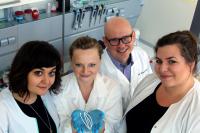Artificial blood vessels or how to help patients with ischaemic heart disease
A team directed by dr inż. Beata Butruk-Raszeja (PhD Eng) of the Faculty of Chemistry and Process Engineering of Warsaw University of Technology is working on coronary prostheses. “We want them to be able to replace impaired vessels,” explains the researcher. Data on cardiovascular diseases has been appalling for years.
According to a report issued by the Polish Central Statistical Office (GUS), 177,000 people died of cardiac causes in Poland in 2013, which accounts for 45.8% of all deaths. Half of them was a result of ischaemic heart disease. Scientists are now coming to help both patients and doctors fighting against it.
Bridge the gap between the artificial and the natural
“We want to most accurately reproduce natural coronary vessels,” explains Doctor Butruk-Raszeja. “Our model will follow their structure. And it is quite a complex one. It has multiple layers that we are going to render from polymer materials, i.e. artificial ones. Our project is different because the last layer or the one in immediate contact with the blood will be natural, so to speak, as we will coat it with cells harvested from the patient.”
This is the stage that will pose the greatest challenge. All attempts to combine artificial surfaces with natural tissue are always very difficult.
No room for error
The solution developed by the researchers addresses acutely real needs of the medical world. Today, if coronary vessels (meaning those around the heart) are blocked, a so-called bypass surgery is performed. Blood vessels are derived from another part of the patient’s body, usually, the lower leg and a bridge are created between the main artery (aorta) and the coronary artery. The blocked section of an artery is bypassed and the blood is rerouted to the heart. However, the procedure is not always feasible. “If a patient has damaged coronary vessels, the other can also be in poor condition, and then healthy vessels will be nowhere to be taken from,” explains Doctor Butruk-Raszeja. “This is where artificial coronary vessels will be of use in particular.”
As pointed out by the researcher, large-diameter vascular prostheses have already been applied in medical practice and with success. However, implants for small-diameter vessels, up to 4–5 mm in diameter (such as coronary ones), that would be sufficiently biocompatible are still not available. “A big challenge that we face is blood clotting,” says Doctor Butruk-Raszeja, “If a small clot forms in a vessel with a large diameter, the blood can still flow. But this won’t be possible in a small-diameter vessel.”
In other words, there is no room for even the smallest error.
Putting the pieces together
Such complex research requires knowledge that cuts across various fields: material engineering, material resistance, cell culture, in vitro and in vivo processes and general biological and medical knowledge.
“We have already got the various components of the prosthesis and now will be putting them together,” says Doctor Butruk-Raszeja. “We can forecast what can go wrong, that’s why we have our B and C backup plans. The research will have to take multiple tracks.”
The team of scientists comprises 6 members: 4 people from Warsaw University of Technology and 2 people from the Institute of Metallurgy and Materials Science, Polish Academy of Sciences. The project is supported by the Research and Development Centre operating in the Polish-American Heart Clinic network as the subcontractor. “They have a history of various prosthesis testing so we rely on them for their know-how and experience,” says Doctor Butruk-Raszeja.
Waiting for a breakthrough
The researcher of Warsaw University of Technology was granted a subsidy under the LEADER Program managed by the National Centre for Research and Development. In three years (this is the grant period) prostheses will definitely not be ready for commercialization yet. A commercial launch of medical implants is a very long process. “First, components are created and then put together into a whole and tested during the preliminary physical, chemical and mechanical testing phase,” says Doctor Butruk-Raszeja. “If the outcome is satisfactory, biological testing follows, this time on cells and also on blood as in this case. The next stage is short- and long-term animal testing. We want to make it through to that point during the NCRD grant period.”
When can we expect coronary prostheses created at Warsaw University of Technology to be in use? “It’s very hard to say at this time,” says Doctor Butruk-Raszeja. “Clinical trials will have to be conducted once the animal tests are completed. Ant this is a very complicated and costly process.”
Agnieszka Kapela
Office for Promotion and Information








